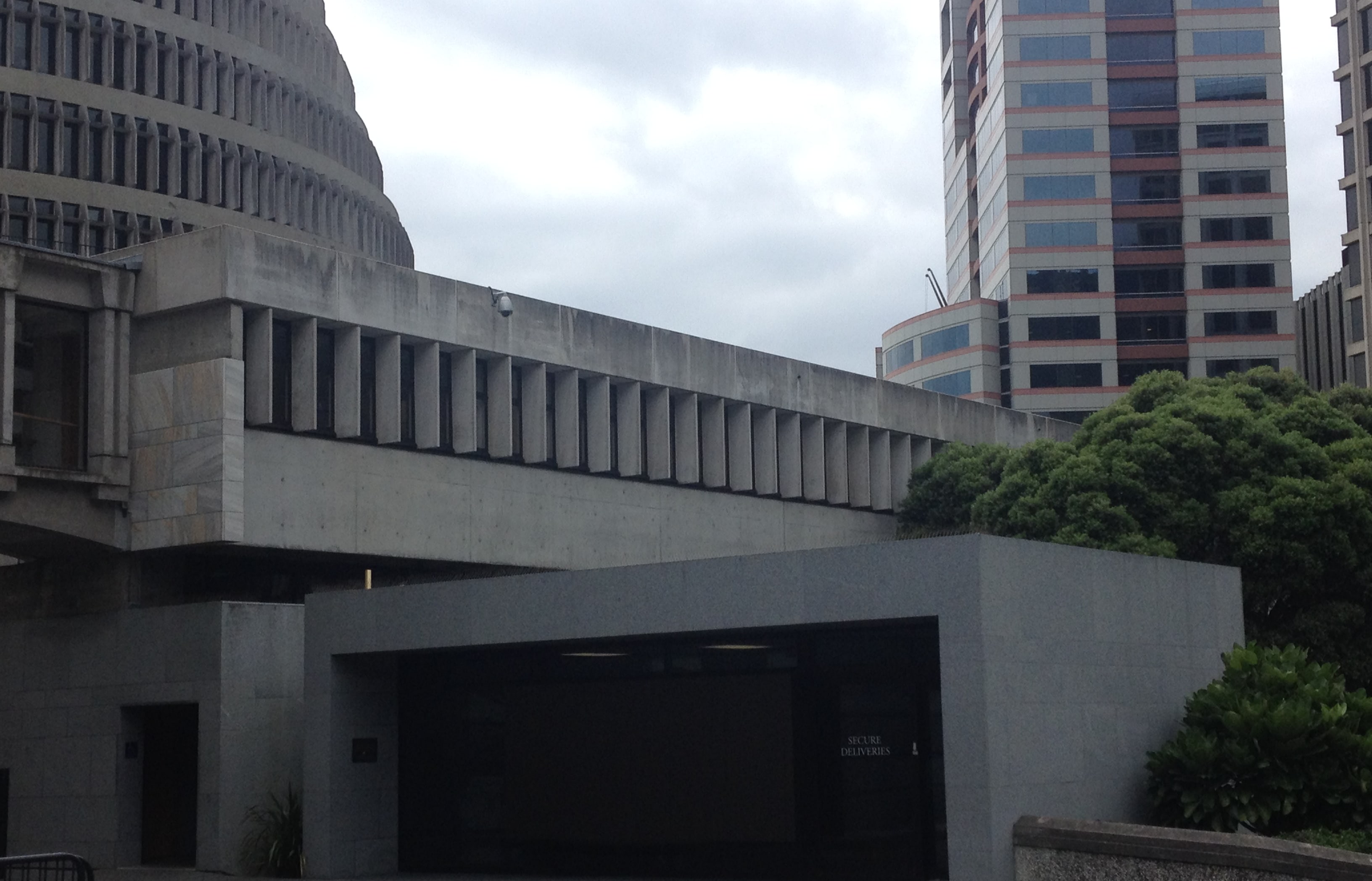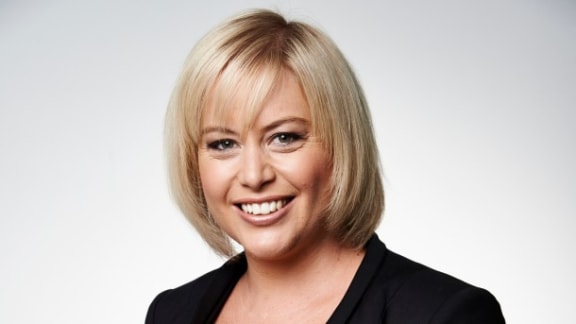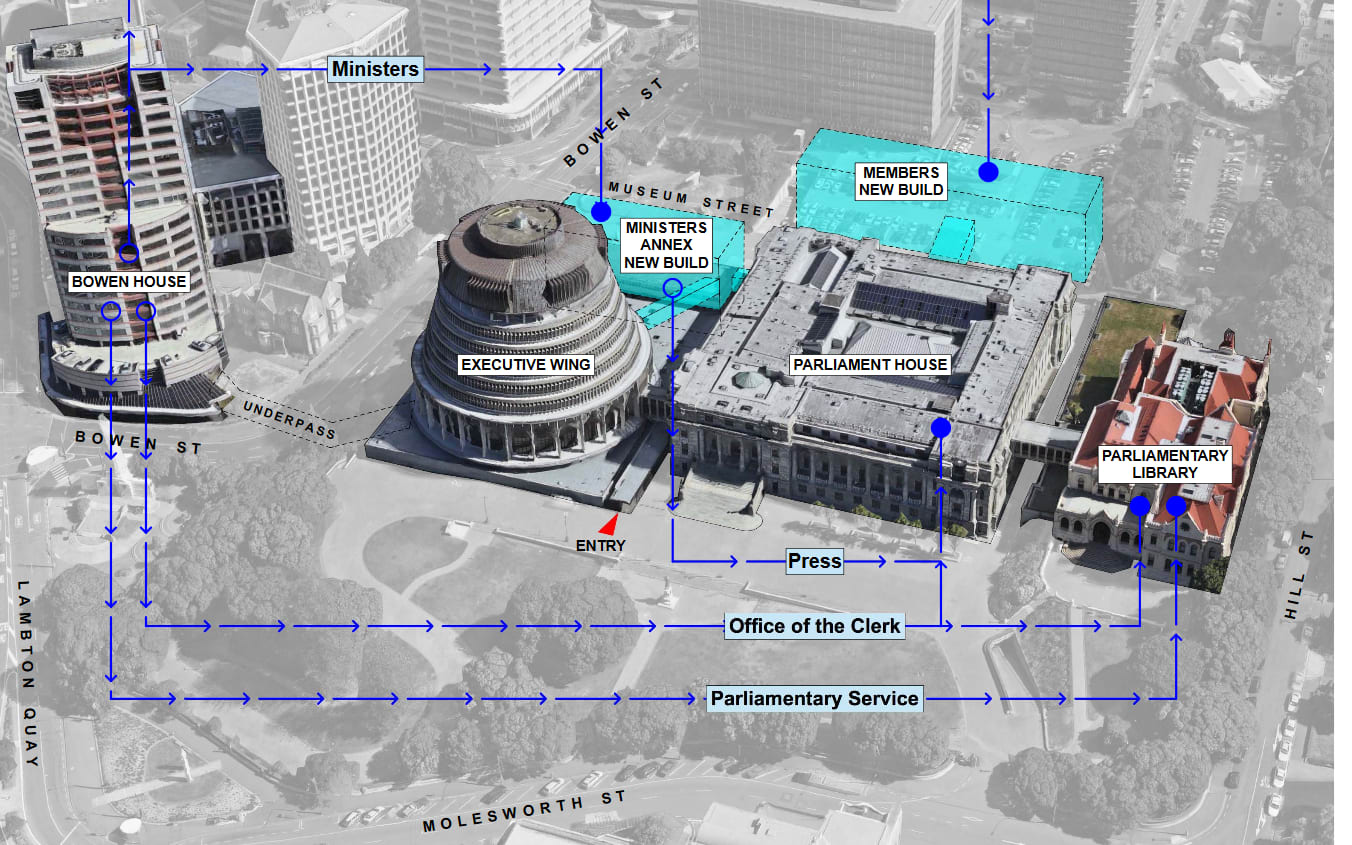Expensive new buildings for Parliament were unveiled this week, just after most of the nation's political journalists walked out of their earthquake-prone offices. Is the fourth estate getting second class treatment?

Parliament's Press Gallery annexe: the brutalist and earthquake prone" home of political journalists. Photo: RNZ / Colin Peacock
Political reporters at Parliament last Monday dutifully reported the unveiling of plans for shiny new buildings to house politicians, including government ministers.
Newstalk ZB’s political reporter Felix Marwick said the probable price tag of more than $100 million wouldn’t go down well with "those who have their lives ripped apart, and homes turned upside down in the South Island quakes of the last two weeks".
"When new roads and houses are needed, when communities need to be reconnected, our politicians are in line for new digs," wrote Felix Marwick.
Cartoonists also saw it as one housing problem that could be fixed with political support.
This week's cartoon by @Slanecartoons pic.twitter.com/a0m0nnqutI
— New Zealand Listener (@nzlistener) December 1, 2016
But it’s not just the politicians getting new digs from this - so are the political journalists. The building housing the parliamentary press gallery (and Parliament's pool and gym) will have to go to make room.
Leaving the building
But long before the wrecking ball arrives, most political reporters have already left. They exited in a hurry late last week because the press gallery building is an earthquake risk.
That itself was not news. The building's had a yellow sticker on it saying so since 2014.
"It is correct that the annexe in which the press gallery is located is not up to the full 100 percent standard of code. It is not identified—as in, being under 33 percent—as an earthquake-prone building, but I would commend both the Speaker and the Leader of the House on the work that they are doing to upgrade these buildings and make them safer for all their occupants," building and housing minister Nick Smith told Parliament just a week before the journalists walked out.
Political reporters have not objected strongly to working in the building before now. So what changed?

TVNZ reporter Katie Bradford, current press gallery chair. Photo: supplied / TVNZ
Press galley chair Katie Bradford - also a reporter for TVNZ - told Mediawatch the building was checked again after the recent quakes and an engineer's report concluded parts of it met just 15 to 20 percent of the current building code.
TVNZ, Newstalk ZB, Newshub, Fairfax NZ and The New Zealand Herald all told their staff to leave late last week.
RNZ reporters were the first to go when RNZ chief executive Paul Thompson made the call.
"There is a stronger possibility of another quake. I wasn't comfortable having our staff there," he told Mediawatch.
Too little, too late?
Fairfax Media moved staff out of the Dominion Post's building in Wellington promptly when it was deemed an earthquake risk in 2013. Why didn't the media companies move their staff out of the yellow-stickered building at Parliament before now?
Mr Thompson said there was an initial plan to the strengthen the building, but that was superceded by the decision to replace it with one of the new buildings announced this week.
"In a way, we all dropped the ball on this. Both the media and the Parliamentary Service should have been onto this a bit sooner," he said.

Concept drawings for new parliament buildings Photo: Parliament
Having experienced the Christchurch quakes five years ago, Fairfax reporter Sam Sachdeva thinks Wellington isn't taking taking the risks seriously enough - Parliament included.
"No strengthening work has taken place," he said in a Dominion Post opinion piece last weekend.
"Statues of former prime ministers Richard Seddon and John Ballance (are) seemingly a greater priority for the Parliamentary Service than living, breathing humans," he wrote.
"There is an element of that. I would be surprised if MPs or other staff would be allowed to work in an earthquake-prone building," Mr Thompson said.
However, he said the Parliamentary Service had been very helpful once the decision to leave was made, finding journalists alternative space and facilities in a hurry.
That wasn't easy, according to Ms Bradford, who said Parliament pulled out all the stops in the weekend to help.
"There are 49 of us - more than the Labour caucus," she told Mediawatch.
Is it no coincidence political journalists are in the least-loved and most at-risk part of Parliament?
"It may be a reflection of how people feel about us, but they didn't have us there with an intention of harm coming to us."
But once the building was known to be a risk, the option of strengthening at a cost of $10 million was investigated. Once the employers were aware parts of the building were below 30 percent of code, the decision to leave was made straight away given the other option was to spend another year in the building.
Mr Thompson insists the political journalists are as essential as anyone else in Parliament. But the media companies do not pay rent and Parliament is not obliged by law to house them.
"The convention is that we are there and we should be accommodated to a good level," he said.
"We're not looking for palatial surrounding or marble floors or anything like that."
Previous building plans led to the demolition of RNZ's Broadcasting House at Parliament in 1997 and there was nothing RNZ could do about it.
One reason the current press gallery is being knocked down is because Parliament doesn't want to do deals with others for its accommodation. So should the media have the same sort of independence - and their won premises for covering politics?
"Press galleries are part of most parliaments around the world, and we should be there," Ms Bradford said.

